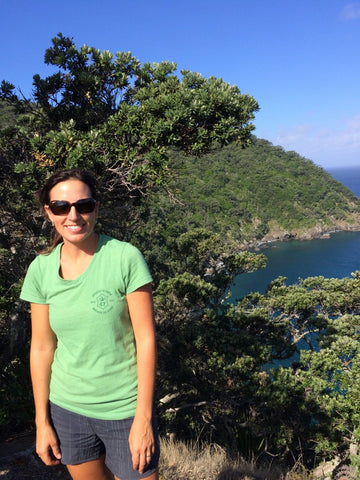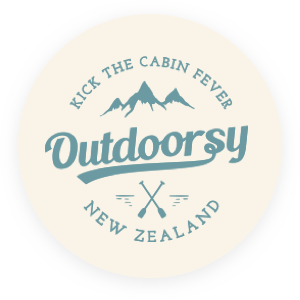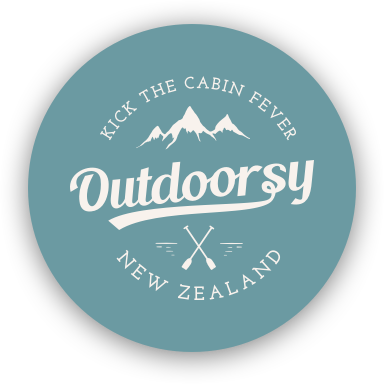Living The Wild Life - Volunteering on an island nature reserve
March 29 2016

‘You need to be reasonably fit,’ they said. ‘You need to be ok with heights,’ they said. They were right. I would add to that – no problem with creepy crawlies, all over you, most of the time. No allergy to bee or wasp stings. An ability to carry large heavy plastic containers up a ladder would be a bonus. And some boat handling skills will come in handy, too. If you can tick off all of those things on a list, you’ll have the most amazing experience if you volunteer for DoC on a remote island wildlife reserve!
Last week I was lucky enough to get out to Whatupuke Island (What a puke, says Mum) with the Department of Conservation. Whatupuke is one of the Hen and Chickens group located off Northland’s east coast – all of the islands in the group are wildlife reserves and landing is not permitted to the public. There’s been significant investment into protection of these little gems which are home to tuatara (I saw three in five minutes!) and rare native birds like Saddleback, Rifleman, Kaka, Kukupa (native wood pigeon up here are not called Kereru), Tui, Fantail, Bellbird, you name it…the chorus of song in the treetops is testament to the efforts to eradicate pests such as possums, mice and rats.

We were there to combat a different kind of pest – invasive weeds. Now that I’ve been there it seems funny to describe it as a ‘delicate environment,’ with its crashing surf, bouldery beaches, dramatic cliffs and wind whipped canopy – but it really is. The ecology of a small tree covered rock in the ocean is very much on tenterhooks once people arrive and set about disturbing the balance by bringing ‘alien’ seeds, insects, and animals with them. There are a small number of weeds which will really take off and smother the native plant species if left to their own devices – so our mission was to ‘weedle’ any of them out before they could really take root.
DoC Northland has a dedicated weed team of four who tackle these projects on the islands between September and March every year. These guys and girls are tough. As I laboured up a hill behind them they literally did leave me in their dust! I could tell that they’d been out there scaling these heights for the last six months, as I scrabbled for hand holds and tried to summon my inner mountain goat. It’s surprising how quickly you adapt, though – I felt faster and more agile at covering the terrain by the end of the second day even though strange muscles I didn’t know I had were protesting feebly.

Each morning you’re up at first light to make the most of the day. This is really physical work, so I ate triple the amount of breakfast I usually would – a heaping bowl full of muesli, with extra nuts sprinkled on top, yoghurt, and chopped apple. Then it’s time to make your lunch – two sandwiches and plenty of snacks for morning and afternoon tea – muesli bars, fruit, scroggin, and at least 1.5 litres of water.
There were seven of us (four DoC workers and three volunteers) so we’d often split into two groups and cover different parts of the island. We’d hike up the main access trail to the ridge and then start looking for the GPS waypoint of the weed site we were targeting. This is when the serious ‘bush crashing’ starts – you spread out and make your way down hill, slipping and sliding, looking for the ‘home tree’ of each site with its pink tapes telling us weeds had been found there previously. Then you continue on down looking for weeds (eg Mexican Devil, Pampas) as far as you can go – sometimes we made it all the way to the coastline, but often rocky buttresses or vertical drop offs cut us off. Frequently you’re not really aware of the vertical drop off until you’re virtually upon it in a bundle of flax – as I said, a head for heights is most definitely a requirement! Any weeds are pulled out and duly noted, then it’s back up the slope any way you can make it. Did I mention this island is steep? The scree slides away underfoot and you are reliant on tree roots, branches, and rock holds to propel yourself upwards…if you’re terrified of falling, at least it makes you go faster. Then it’s on to the next site.

I was fascinated by the thought that this place had never been cleared. It had never been farmed, or had wild pigs like the Poor Knights islands, or even had a building put up. This was not regenerating bush, it was as it always had been. When Maori tribes summered here hundreds of years ago, they looked up at the trees I was looking up at. They heard the bird song I was hearing. They weaved their way through the undergrowth just as I was.
At the end of the day we’d return to camp covered in sweat, grime, cuts and abrasions, hair full of twigs, and dog-tired. The boots are flung off, the truly revolting socks peeled away, togs on, stagger down the rocky gully and wobble over the boulders, then – ahhhh! – to fling yourself into the ocean never felt so good. The turbulent water bounced us around in the bay, and we didn’t care that it was full of jelly like fish spawn – indeed, there were large schools of blue Maomao weaving around under our feet, too. Just being weightless, cool, and clean felt so so good.

Unfortunately our trip was cut short by an approaching weather system – the skipper of the charter boat coming to pick us up was concerned at our ability to actually get off the beach safely. And even in fine weather, it is a mission to pack up the tents and everything you’ve carried in, chain gang all the gear through a rocky gully, down a ladder onto the boulders, and ferry it over crashing surf and out to the boat in an inflatable dinghy on two lines. It took well over an hour to get everything on board, and as we coasted back towards the looming Whangarei Heads in a 4.5 metre swell I reflected that it was not the relaxing trip (away from the toddler!) that I had been looking forward to. It was exciting, challenging, exhausting, at times downright scary, and uncomfortable. But it was also a total privilege to be there. The people were fun, dedicated, and seriously admirable – and the islands themselves are beguiling. If they’ll have me, I can’t wait to go back next season.
The Department of Conservation has many different opportunities to participate as a volunteer. If you’re interested in applying, get involved here!

